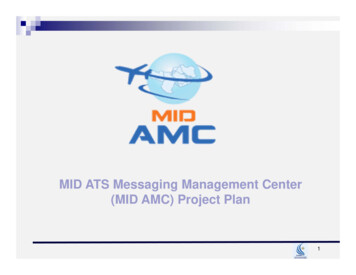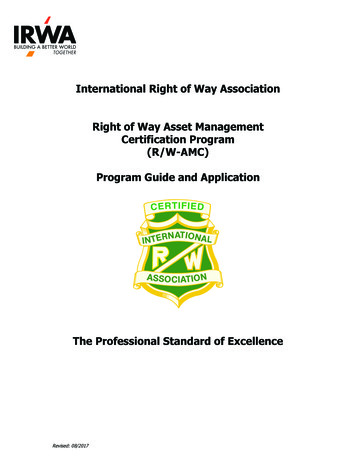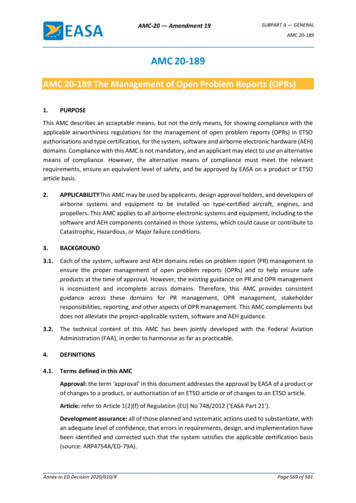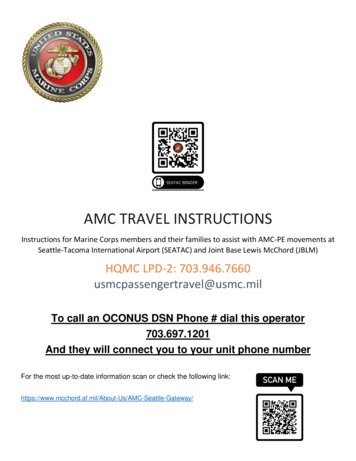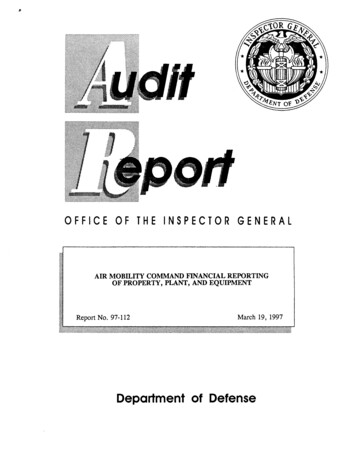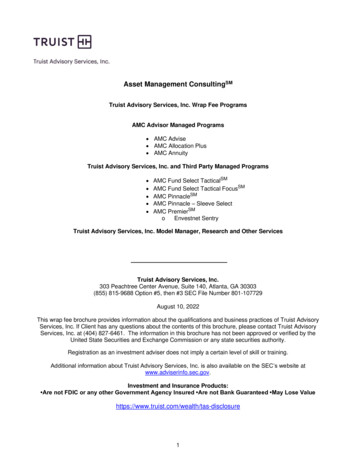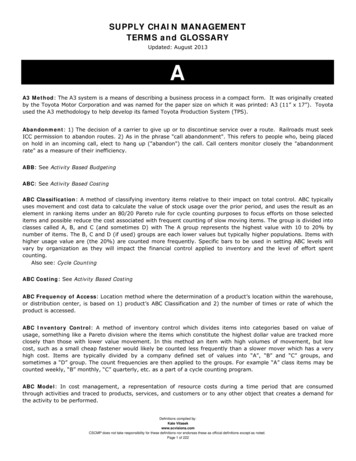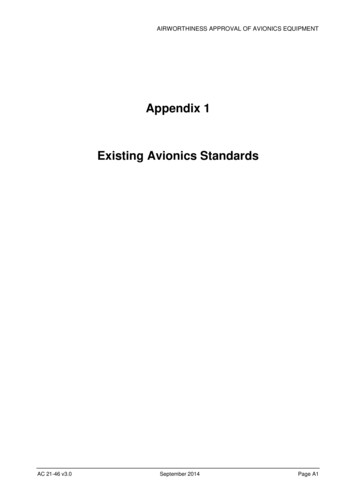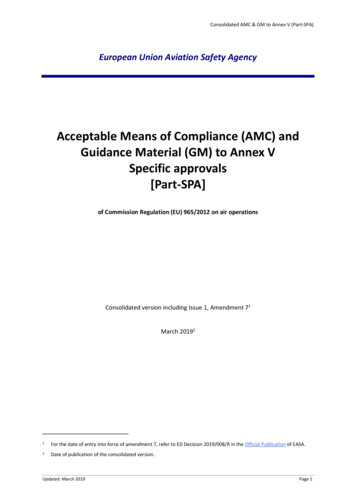
Transcription
Consolidated AMC & GM to Annex V (Part-SPA)European Union Aviation Safety AgencyAcceptable Means of Compliance (AMC) andGuidance Material (GM) to Annex VSpecific approvals[Part-SPA]of Commission Regulation (EU) 965/2012 on air operationsConsolidated version including Issue 1, Amendment 71March 201921For the date of entry into force of amendment 7, refer to ED Decision 2019/008/R in the Official Publication of EASA.2Date of publication of the consolidated version.Updated: March 2019Page 1
EASA DecisionConsolidated AMC & GM to Annex V (Part-SPA)DisclaimerDisclaimerThis consolidated document includes the initial issue of and all subsequent amendments to theAMC&GM associated with this Annex.It is an unofficial document, intended for the easy use of stakeholders, and is meant purely as adocumentation tool. The Agency does not assume any liability for its contents.The official documents can be found at lpublication.Updated: March 2019Page 2
EASA DecisionConsolidated AMC & GM to Annex V (Part-SPA)Summary of amendmentsSummary of amendmentsChapterSubpart M: Electronic Flight Bags:ActionIssue/Amdt.no.New1/7all AMC and GMAmended by ED Decision (stand-alone orfollowing publication of a certainamending regulation)EDD 2018/008/R (EFB)(rel. to R.(EU) 2018/1975)AMC1 SPA.RVSM.105ChangedAMC2 SPA.RVSM.105ChangedAMC3 SPA.RVSM.105New1/6EDD 2017/009/R (Update of OPS rules)Reg. (EU) No 2017/363 andGM1 SPA.RVSM.105(d)(9)ChangedAMC5 SPA.LVO.105ChangedAMC6 SPA.LVO.105ChangedAMC1 SPA.LVO.120ChangedAMC1 SPA.DG.105(a)ChangedSubpart L – Single-engined turbineaeroplane operations at night or ininstrument meteorological conditions(SET-IMC)NewSubpart1/5Subpart K – Helicopter Offshoreoperations (HOFO)NewSubpart1/4EDD 2017/004/R (SET-IMC)Reg. (EU) No 2016/1199 andEDD 2016/022/RApplicable from 01/07/2018GM1 SPA.PBN.100NewAMC1 SPA.PBN.105(b)NewAMC1 SPA.PBN.105(c)NewGM1 SPA.PBN.105(c)NewAMC1 SPA.PBN.105(d)NewAMC2 SPA.PBN.105(d)NewAMC3 SPA.PBN.105(d)NewAMC1 SPA.PBN.105(e)NewAMC1 SPA.PBN.105(f)NewAMC1 SPA.HEMS.135(a)Amended1/3Issue 1Reg. (EU) No 2016/1199 andEDD 2016/020/R (PBN)ED Decision 2015/022/R (CRM training)Amdt. 2AMC1 SPA.GEN.105(a)AmendedAMC1 SPA.RVSM.105AmendedAMC1 SPA.LVO.125AmendedUpdated: March 2019Amdt. 1ED Decision 2013/020/R;Reg. (EU) No 800/2013 on NCC and NCOPage 3
EASA DecisionConsolidated AMC & GM to Annex V (Part-SPA)SPA.GENSUBPART A:GENERAL REQUIREMENTSAMC1 SPA.GEN.105(a) Application for a specific approvalDOCUMENTATION(a)Operating procedures should be documented in the operations manual.(b)If an operations manual is not required, operating procedures may be described in a manualspecifying procedures (procedures manual). If the aircraft flight manual (AFM) or the pilotoperating handbook (POH) contains such procedures, they should be considered as acceptablemeans to document the procedures.Updated: March 2019Page 4
EASA DecisionConsolidated AMC & GM to Annex V (Part-SPA)SPA.PBNSUBPART B:PERFORMANCE-BASED NAVIGATION (PBN) OPERATIONSGM1 SPA.PBN.100 PBN operationsGENERAL(a)PBN operations are based on performance requirements, which are expressed in navigationspecifications (RNAV specification and RNP specification) in terms of accuracy, integrity,continuity, availability and functionality needed for the proposed operation in the context of aparticular airspace concept.Table 1 provides a simplified overview of:(1)PBN specifications and their applicability for different phases of flight; and(2)PBN specifications requiring a specific approval.(b)More detailed guidance material for the operational use of PBN applications can be found in ICAODoc 9613 Performance-Based Navigation (PBN) Manual.(c)Guidance material for the design of RNP AR APCH procedures can be found in ICAO Doc 9905 RNPAR Procedure Design Manual.(d)Guidance material for the operational approval of PBN operations can be found in ICAO Doc 9997Performance-Based Navigation (PBN) Operational Approval Manual.Updated: March 2019Page 5
EASA DecisionConsolidated AMC & GM to Annex V (Part-SPA)SPA.PBNTable 1: Overview of PBN specificationsFLIGHT PHASEEn-routeOceanicRNAV artureFinalMissed10RNAV 555RNAV 222RNAV RNP APCH (LNAV)110.31RNP APCH (LNAV/VNAV)110.31RNP APCH (LP)111RNP APCH (LPV)1111–0.11–0.10.30.3RNP 44RNP 222RNP 1A-RNP22 or 1RNP AR APCHRNP 0.3 (H)Numbers specify the accuracy levelUpdated: March 201920.30.3no specific approval required0.3-0.11–0.10.30.3specific approval requiredPage 6
EASA DecisionConsolidated AMC & GM to Annex V (Part-SPA)SPA.MNPSAMC1 SPA.PBN.105(b) PBN operational approvalFLIGHT CREW TRAINING AND QUALIFICATIONS — GENERAL PROVISIONS(a)The operator should ensure that flight crew members training programmes for RNP AR APCHinclude structured courses of ground and FSTD training.(1)Flight crew members with no RNP AR APCH experience should complete the full trainingprogramme prescribed in (b), (c), and (d) below.(2)Flight crew members with RNP AR APCH experience with another EU operator mayundertake an:(i)abbreviated ground training course if operating a different type or class from that onwhich the previous RNP AR experience was gained;(ii)abbreviated ground and FSTD training course if operating the same type or class andvariant of the same type or class on which the previous RNP. AR experience wasgained.(iii)the abbreviated course should include at least the provisions of (d)(1), (c)(1) and(c)(2)(x) as appropriate.(iv)The operator may reduce the number of approaches/landings required by (c)(2)(xii) ifthe type/class or the variant of the type or class has the same or similar:(A)level of technology (flight guidance system (FGS));(B)operating procedures for navigation performance monitoring; and(C)handling characteristicsas the previously operated type or class.(3)Flight crew members with RNP AR APCH experience with the operator may undertake anabbreviated ground and FSTD training course:(i)when changing aircraft type or class, the abbreviated course should include at leastthe provisions of (d)(1), (c)(1), (c)(2);(ii)when changing to a different variant of aircraft within the same type or class ratingthat has the same or similar of all of the following:(A)level of technology (flight guidance system (FGS));(B)operating procedures for navigation performance monitoring; and(C)handling characteristicsas the previously operated type or class.A difference course or familiarisation appropriate to the change of variant shouldfulfil the abbreviated course provisions.(iii)when changing to a different variant of aircraft within the same type or class ratingthat has significantly different at least one of the following:(A)level of technology (FGS);(B)operating procedures for navigation performance monitoring; and(C)handling characteristics,the provisions of (c)(1) and (c)(2) should be fulfilled.Updated: March 2019Page 7
EASA Decision(4)Consolidated AMC & GM to Annex V (Part-SPA)SPA.MNPSThe operator should ensure when undertaking RNP AR APCH operations with differentvariant(s) of aircraft within the same type or class rating, that the differences and/orsimilarities of the aircraft concerned justify such operations, taking into account at least thefollowing:(i)(ii)(iii)(b)the level of technology, including the:(A)FGS and associated displays and controls;(B)FMS and its integration or not with the FGS; and(C)on-board performance monitoring and alerting (OBPMA) system;operating procedures, including:(A)navigation performance monitoring;(B)approach interruption and missed approach including while in turn along an RFleg;(C)abnormal procedures in case of loss of system redundancy affecting theguidance or the navigation; and(D)abnormal and contingency procedures in case of total loss of RNP capability;andhandling characteristics, including:(A)manual approach with RF leg;(B)manual landing from automatic guided approach; and(C)manual missed approach procedure from automatic approach.Ground training(1)Ground training for RNP AR APCH should address the following subjects during the initialintroduction of a flight crew member to RNP AR APCH systems and operations. Forrecurrent programmes, the curriculum need only review initial curriculum items andaddress new, revised, or emphasised items.(2)General concepts of RNP AR APCH operation(i)RNP AR APCH training should cover RNP AR APCH systems theory to the extentappropriate to ensure proper operational use. Flight crew members shouldunderstand basic concepts of RNP AR APCH systems, operation, classifications, andlimitations.(ii)The training should include general knowledge and operational application ofRNP AR APCH instrument approach procedures. This training module should inparticular address the following specific elements:Updated: March 2019(A)the definitions of RNAV, RNP, RNP APCH, RNP AR APCH, RAIM, andcontainment areas;(B)the differences between RNP AR APCH and RNP APCH;(C)the types of RNP AR APCH procedures and familiarity with the charting ofthese procedures;(D)the programming and display of RNP and aircraft specific displays, e.g. actualnavigation performance;Page 8
EASA DecisionUpdated: March 2019Consolidated AMC & GM to Annex V (Part-SPA)SPA.MNPS(E)the methods to enable and disable the navigation updating modes related toRNP;(F)the RNP values appropriate for different phases of flight and RNP AR APCHinstrument procedures and how to select, if necessary;(G)the use of GNSS RAIM (or equivalent) forecasts and the effects of RAIM ‘holes’on RNP AR APCH procedures availability;(H)when and how to terminate RNP navigation and transfer to conventionalnavigation due to loss of RNP and/or required equipment;(I)the method to determine if the navigation database is current and containsrequired navigational data;(J)the explanation of the different components that contribute to the totalsystem error and their characteristics, e.g. drift characteristics when using IRUwith no radio updating, QNH mistakes;(K)the temperature compensation: Flight crew members operating avionicssystems with compensation for altimetry errors introduced by deviations fromISA may disregard the temperature limits on RNP AR APCH procedures if flightcrew training on use of the temperature compensation function is provided bythe operator and the compensation function is utilised by the crew. However,the training should also recognise if the temperature compensation by thesystem is applicable to the VNAV guidance and is not a substitute for the flightcrew compensating for the temperature effects on minimum altitudes or theDA/H;(L)the effect of wind on aircraft performance during RNP AR APCH operationsand the need to positively remain within RNP containment area, including anyoperational wind limitation and aircraft configuration essential to safelycomplete an RNP AR APCH operation;(M)the effect of groundspeed on compliance with RNP AR APCH procedures andbank angle restrictions that may impact on the ability to remain on the coursecentreline. For RNP procedures, aircraft are expected to maintain the standardspeeds associated with the applicable category unless more stringentconstraints are published;(N)the relationship between RNP and the appropriate approach minima line onan approved published RNP AR APCH procedure and any operationallimitations if the available RNP degrades or is not available prior to anapproach (this should include flight crew operating procedures outside the FAFversus inside the FAF);(O)understanding alerts that may occur from the loading and use of improperRNP values for a desired segment of an RNP AR APCH procedure;(P)understanding the performance requirement to couple the autopilot/flightdirector to the navigation system’s lateral guidance on RNP AR APCHprocedures requiring an RNP of less than RNP 0.3;(Q)the events that trigger a missed approach when using the aircraft’s RNPcapability to complete an RNP AR APCH procedure;(R)any bank angle restrictions or limitations on RNP AR APCH procedures;Page 9
EASA Decision(3)(4)(5)(6)Consolidated AMC & GM to Annex V (Part-SPA)SPA.MNPSensuring flight crew members understand the performance issues associatedwith reversion to radio updating, know any limitations on the use of DME andVOR updating; and(T)the familiarisation with the terrain and obstacles representations onnavigation displays and approach charts.ATC communication and coordination for use of RNP AR APCH(i)Ground training should instruct flight crew members on proper flight planclassifications and any ATC procedures applicable to RNP AR APCH operations.(ii)Flight crew members should receive instruction on the need to advise ATCimmediately when the performance of the aircraft’s navigation system is no longeradequate to support continuation of an RNP AR APCH operation.RNP AR APCH equipment components, controls, displays, and alerts(i)Theoretical training should include discussion of RNP terminology, symbology,operation, optional controls, and display features, including any items unique to anoperator’s implementation or systems. The training should address applicable failurealerts and limitations.(ii)Flight crew members should achieve a thorough understanding of the equipmentused in RNP operations and any limitations on the use of the equipment during thoseoperations.(iii)Flight crew members should also know what navigation sensors form the basis fortheir RNP AR APCH compliance, and they should be able to assess the impact offailure of any avionics or a known loss of ground systems on the remainder of theflight plan.AFM information and operating procedures(i)Based on the AFM or other aircraft eligibility evidence, the flight crew should addressnormal and abnormal operating procedures, responses to failure alerts, and anylimitations, including related information on RNP modes of operation.(ii)Training should also address contingency procedures for loss or degradation of theRNP AR APCH capability.(iii)The manuals used by the flight should contain this information.MEL operating provisions(i)(c)(S)Flight crew members should have a thorough understanding of the MEL entriessupporting RNP AR APCH operations.Initial FSTD training(1)In addition to ground training, flight crew members should receive appropriate practical skilltraining in an FSTD.(i)Training programmes should cover the proper execution of RNP AR APCH operationsin compliance with the manufacturer’s documentation.(ii)The training should include:Updated: March 2019(A)RNP AR APCH procedures and limitations;(B)standardisation of the set-up of the cockpit’s electronic displays during anRNP AR APCH operation;Page 10
EASA Decision(2)Consolidated AMC & GM to Annex V (Part-SPA)SPA.MNPS(C)recognition of the aural advisories, alerts and other annunciations that canimpact on compliance with an RNP AR APCH procedure; and(D)the timely and correct responses to loss of RNP AR APCH capability in a varietyof scenarios embracing the breadth of the RNP AR APCH procedures theoperator plans to complete.FSTD training should address the following specific elements:(i)procedures for verifying that each flight crew member’s altimeter has the currentsetting before commencing the final approach of an RNP AR APCH operation,including any operational limitations associated with the source(s) for the altimetersetting and the latency of checking and setting the altimeters for landing;(ii)use of aircraft RADAR, TAWS or other avionics systems to support the flight crew’strack monitoring and weather and obstacle avoidance;(iii)concise and complete flight crew briefings for all RNP AR APCH procedures and theimportant role crew resource management (CRM) plays in successfully completing anRNP AR APCH operation;(iv)the importance of aircraft configuration to ensure the aircraft maintains anymandated speeds during RNP AR APCH operations;(v)the potentially detrimental effect of reducing the flap setting, reducing the bankangle or increasing airspeeds may have on the ability to comply with an RNP AR APCHoperation;(vi)flight crew members understand and are capable of programming and/or operatingthe FMC, autopilot, autothrottles, RADAR, GNSS, INS, EFIS (including the movingmap), and TAWS in support of RNP AR APCH operations;(vii)handling of TOGA to LNAV transition as applicable, particularly while in turn;(viii) monitoring of flight technical error (FTE) and related go-around operation;(ix)handling of loss of GNSS signals during a procedure;(x)handling of engine failure during the approach operation;(xi)applying contingency procedures for a loss of RNP capability during a missedapproach. Due to the lack of navigation guidance, the training should emphasise theflight crew contingency actions that achieve separation from terrain and obstacles.The operator should tailor these contingency procedures to their specificRNP AR APCH procedures; and(xii)as a minimum, each flight crew member should complete two RNP approachprocedures for each duty position (pilot flying and pilot monitoring) that employ theunique RNP AR APCH characteristics of the operator’s RNP AR APCH procedures (e.g.RF legs, missed approach). One procedure should culminate in a transition to landingand one procedure should culminate in execution of an RNP missed approachprocedure.FLIGHT CREW TRAINING AND QUALIFICATIONS — CONVERSION TRAINING(d)Flight crew members should complete the following RNP AR APCH training if converting to a newtype or class or variant of aircraft in which RNP AR operations will be conducted. For abbreviatedcourses, the provisions prescribed in (a)(2), (a)(3) and (a)(4) should apply.Updated: March 2019Page 11
EASA Decision(1)Consolidated AMC & GM to Annex V (Part-SPA)SPA.MNPSGround trainingTaking into account the flight crew member's RNP AR APCH previous training andexperience, flight crew members should undertake an abbreviated ground training thatshould include at least the provisions of (b)(2)(D) to (I), (b)((2)(N) to (R), (b)(2)(S), and (b)(3)to (6).(2)FSTD trainingThe provisions prescribed in (a) should apply, taking into account the flight crew member'sRNP AR APCH training and experience.FLIGHT CREW TRAINING AND QUALIFICATIONS — RNP AR APCH PROCEDURES REQUIRING APROCEDURE-SPECIFIC APPROVAL(e)Before starting an RNP AR APCH procedure for which a procedure-specific approval is required,flight crew members should undertake additional ground training and FSTD training, asappropriate.(1)The operator should ensure that the additional training programmes for such proceduresinclude as at least all of the following:(i)the provisions of (c)(1), (c)(2)(x) as appropriate and customised to the intendedoperation;(ii)the crew training recommendations and mitigations stated in the procedure flightoperational safety assessment (FOSA); and(iii)specific training and operational provision published in the AIP, where applicable.(2)Flight crew members with prior experience of RNP AR APCH procedures for which aprocedure-specific approval is required may receive credit for all or part of these provisionsprovided the current operator’s RNP AR APCH procedures are similar and require no newpilot skills to be trained in an FSTD.(3)Training and checking may be combined and conducted by the same person with regard to(f)(2).(4)In case of a first RNP AR APCH application targeting directly RNP AR APCH proceduresrequiring procedure-specific approvals, a combined initial and additional training andchecking, as appropriate, should be acceptable provided the training and checking includesall provisions prescribed by (a), (b), (c), (d) as appropriate, (e) and (f).FLIGHT CREW TRAINING AND QUALIFICATIONS — CHECKING OF RNP AR APCH KNOWLEDGE(f)Initial checking of RNP AR APCH knowledge and procedures(1)The operator should check flight crew members’ knowledge of RNP AR APCH proceduresprior to employing RNP AR APCH operations. As a minimum, the check should include athorough review of flight crew procedures and specific aircraft performance requirementsfor RNP AR APCH operations.(2)The initial check should include one of the following:(i)A check by an examiner using an FSTD.(ii)A check by a TRE, CRE, SFE or a commander nominated by the operator during LPCs,OPCs or line flights that incorporate RNP AR APCH operations that employ the uniqueRNP AR APCH characteristics of the operator’s RNP AR APCH procedures.Updated: March 2019Page 12
EASA DecisionConsolidated AMC & GM to Annex V (Part-SPA)SPA.MNPS(iii)(3)Line-oriented flight training (LOFT)/line-oriented evaluation (LOE). LOFT/LOEprogrammes using an FSTD that incorporates RNP AR APCH operations that employthe unique RNP AR APCH characteristics (i.e. RF legs, RNP missed approach) of theoperator’s RNP AR APCH procedures.Specific elements that should be addressed are:(i)demonstration of the use of any RNP AR APCH limits/minimums that may impactvarious RNP AR APCH operations;(ii)demonstration of the application of radio-updating procedures, such as enabling anddisabling ground-based radio updating of the FMC (e.g. DME/DME and VOR/DMEupdating) and knowledge of when to use this feature;(iii)demonstration of the ability to monitor the actual lateral and vertical flight pathsrelative to programmed flight path and complete the appropriate flight crewprocedures when exceeding a lateral or vertical FTE limit;(iv)demonstration of the ability to read and adapt to a RAIM (or equivalent) forecast,including forecasts predicting a lack of RAIM availability;(v)demonstration of the proper set-up of the FMC, the weather RADAR, TAWS, andmoving map for the various RNP AR APCH operations and scenarios the operatorplans to implement;(vi)demonstration of the use of flight crew briefings and checklists for RNP AR APCHoperations with emphasis on CRM;(vii)demonstration of knowledge of and ability to perform an RNP AR APCH missedapproach procedure in a variety of operational scenarios (i.e. loss of navigation orfailure to acquire visual conditions);(viii) demonstration of speed control during segments requiring speed restrictions toensure compliance with an RNP AR APCH procedure;(ix)demonstration of competent use of RNP AR APCH plates, briefing cards, andchecklists;(x)demonstration of the ability to complete a stable RNP AR APCH operation: bankangle, speed control, and remaining on the procedure’s centreline; and(xi)knowledge of the operational limit for deviation from the desired flight path and ofhow to accurately monitor the aircraft’s position relative to vertical flight path.FLIGHT CREW TRAINING AND QUALIFICATIONS — RECURRENT TRAINING(g)The operator should incorporate recurrent training that employs the unique RNP AR APCHcharacteristics of the operator’s RNP AR APCH procedures as part of the overall trainingprogramme.(1)A minimum of two RNP AR APCH should be flown by each flight crew member, one for eachduty position (pilot flying and pilot monitoring), with one culminating in a landing and oneculminating in a missed approach, and may be substituted for any required 3D approachoperation.(2)In case of several procedure-specific RNP AR APCH approvals, the recurrent training shouldfocus on the most demanding RNP AR APCH procedures giving credit on the less demandingones.Updated: March 2019Page 13
EASA DecisionConsolidated AMC & GM to Annex V (Part-SPA)SPA.MNPSTRAINING FOR PERSONNEL INVOLVED IN THE FLIGHT PREPARATION(h)The operator should ensure that training for flight operation officers/dispatchers should include:(1)the different types of RNP AR APCH procedures;(2)the importance of specific navigation equipment and other equipment during RNP AR APCHoperations and related RNP AR APCH requirements and operating procedures;(3)the operator’s RNP AR APCH approvals;(4)MEL requirements;(5)aircraft performance, and navigation signal availability, e.g. GNSS RAIM/predictive RNPcapability tool, for destination and alternate aerodromes.AMC1 SPA.PBN.105(c) PBN operational approvalFLIGHT OPERATIONAL SAFETY ASSESSMENT (FOSA)(a)For each RNP AR APCH procedure, the operator should conduct a flight operational safetyassessment (FOSA) proportionate to the complexity of the procedure.(b)The FOSA should be based on:(c)(1)restrictions and recommendations published in AIPs;(2)the flyability check;(3)an assessment of the operational environment;(4)the demonstrated navigation performance of the aircraft; and(5)the operational aircraft performance.The operator may take credit from key elements from the safety assessment carried out by theANSP or the aerodrome operator.GM1 SPA.PBN.105(c) PBN operational approvalFLIGHT OPERATIONAL SAFETY ASSESSMENT (FOSA)(a)Traditionally, operational safety has been defined by a target level of safety (TLS) and specified asa risk of collision of 10-7 per approach operation. For RNP AR APCH operations, conducting theFOSA methodology contributes to achieving the TLS. The FOSA is intended to provide a level offlight safety that is equivalent to the traditional TLS, but using methodology oriented toperformance-based flight operations. Using the FOSA, the operational safety objective is met byconsidering more than the aircraft navigation system alone. The FOSA blends quantitative andqualitative analyses and assessments by considering navigation systems, aircraft performance,operating procedures, human factor aspects and the operational environment. During theseassessments conducted under normal and failure conditions, hazards, risks and the associatedmitigations are identified. The FOSA relies on the detailed criteria for the aircraft capabilities andinstrument procedure design to address the majority of general technical, procedure and processfactors. Additionally, technical and operational expertise and prior operator experience withRNP AR APCH operations are essential elements to be considered in the conduct and conclusion ofthe FOSA.(b)The following aspects need to be considered during FOSA, in order to identify hazards, risks andmitigations relevant to RNP AR APCH operations:Updated: March 2019Page 14
EASA DecisionConsolidated AMC & GM to Annex V (Part-SPA)SPA.MNPS(1)Normal performance: lateral and vertical accuracy are addressed in the aircraftairworthiness standards, aircraft and systems operate normally in standard configurationsand operating modes, and individual error components are monitored/truncated throughsystem design or flight crew procedure.(2)Performance under failure conditions: lateral and vertical accuracy are evaluated for aircraftfailures as part of the aircraft certification. Additionally, other rare-normal and abnormalfailures and conditions for ATC operations, flight crew procedures, infrastructure andoperating environment are assessed. Where the failure or condition results are notacceptable for continued operation, mitigations are developed or limitations established forthe aircraft, flight crew and/or operation.(3)Aircraft failures(4)(5)(6)(i)System failure: Failure of a navigation system, flight guidance system, flightinstrument system for the approach, or missed approach (e.g. loss of GNSS updating,receiver failure, autopilot disconnect, FMS failure, etc.). Depending on the aircraft,this may be addressed through aircraft design or operating procedure to cross-checkguidance (e.g. dual equipage for lateral errors, use of terrain awareness and warningsystem).(ii)Malfunction of air data system or altimetry: flight crew procedure cross-checkbetween two independent systems may mitigate this risk.Aircraft performance(i)Inadequate performance to conduct the approach operation: the aircraft capabilitiesand operating procedures ensure that the performance is adequate on eachapproach, as part of flight planning and in order to begin or continue the approach.Consideration should be given to aircraft configuration during approach and anyconfiguration changes associated with a missed approach operation (e.g. enginefailure, flap retraction, re-engagement of autopilot in LNAV mode).(ii)Loss of engine: loss of an engine while on an RNP AR APCH operation is a rareoccurrence due to high engine reliability and the short exposure time. The operatorneeds to take appropriate action to mitigate the effects of loss of engine, initiating ago-around and manually taking control of the aircraft if necessary.Navigation services(i)Use of a navigation aid outside of designated coverage or in test mode: aircraftairworthiness standards and operating procedures have been developed to addressthis risk.(ii)Navigation database errors: instrument approach procedures are validated throughflight validation specific to the operator and aircraft, and the operator should have aprocess defined to maintain validated data through updates to the navigationdatabase.ATC operations(i)Procedure assigned to non-approved aircraft: flight crew are responsible for rejectingthe clearance.(ii)ATC provides ‘direct to’ clearance to or vectors aircraft onto approach such thatperformance cannot be achieved.(iii)Inconsistent ATC phraseology between controller and flight crew.Updated: March 2019Page 15
EASA Decision(7)(8)(9)Consolidated AMC & GM to Annex V (Part-SPA)SPA.MNPSFlight crew operations(i)Erroneous barometric altimeter setting: flight crew entry and cross-check proceduresmay mitigate this risk.(ii)Incorrect procedure selection or loading: flight crew procedures should be availableto verify that the loaded procedure matches the published procedure, line of minimaand aircraft airworthiness qualification.(iii)Incorrect flight control mode selected: training on importance of flight control mode,flight crew procedure to verify selection of correct flight control mode.(iv)Incorrect RNP entry: flight crew procedure to verify RNP loaded in system matchesthe published value.(v)Missed approach: balked landing or rejected landing at or below DA/H.(vi)Poor meteorological conditions: loss or significant reduction of visual reference thatmay result in a go-around.Infrastructure(i)GNSS satellite failure: this conditio
AMC1 SPA.RVSM.105 Changed 1/6 EDD 2017/009/R (Update of OPS rules) AMC2 SPA.RVSM.105 Changed AMC3 SPA.RVSM.105 New GM1 SPA.RVSM.105(d)(9) Changed AMC5 SPA.LVO.105 Changed AMC6 SPA.LVO.105 Changed AMC1 SPA.LVO.120 Changed AMC1 SPA.DG.105(a) Changed Subpart L - Single-engined turbine aeroplane operations at night or in .
